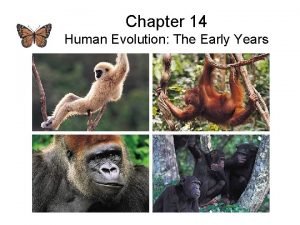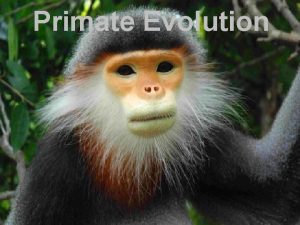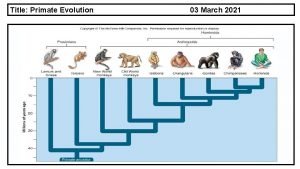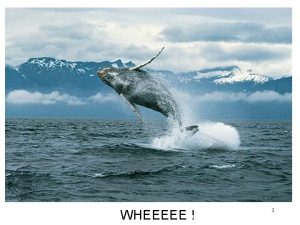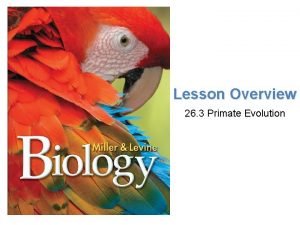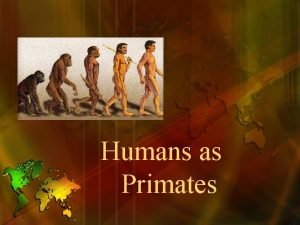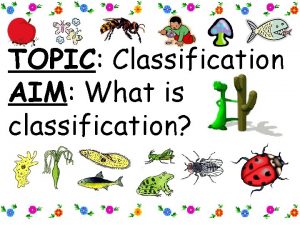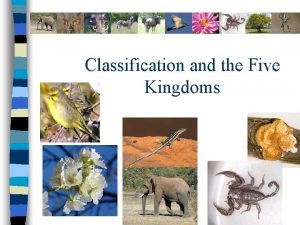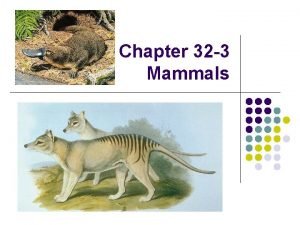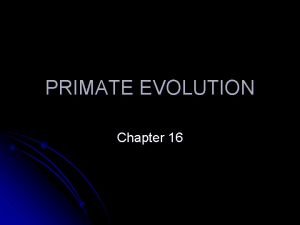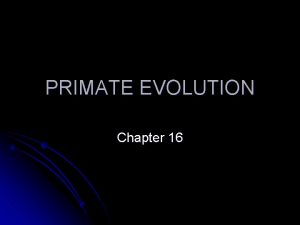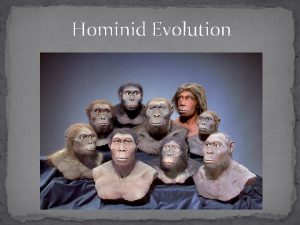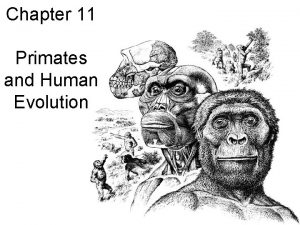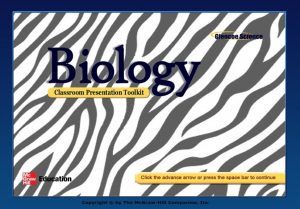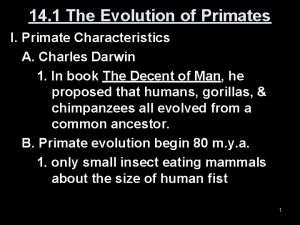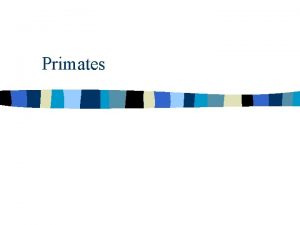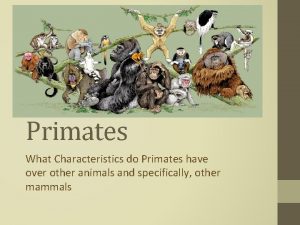PRIMATE EVOLUTION PRIMATES Characteristics of Primates Manual dexterity


















- Slides: 18

PRIMATE EVOLUTION

PRIMATES

Characteristics of Primates � Manual dexterity � Flexible hands and feet � Opposable first digit � Senses � Binocular vision Depth perception � Diurnal Color vision � Locomotion � Flexible shoulders and hips � Brachiation � Walk upright

Characteristics of Primates cont. � Complex brains and behaviors � Problem solving abilities � Well developed social behaviors � Reproductive rates � Reduced number of offspring � Allows for increased time for learning from parents

Primate Groups � � � Most are arboreal Classified according to nose, eyes, and teeth Two groups � Strepsirrhines � Haplorhines

Strepsirrhines � � � Large eyes and ears Only primates that rely heavily on smell for hunting and social interactions Some members can be found in tropical Africa and Asia but most are found in Madagascar and nearby islands

Lemurs, Aye-Aye, Loris, and Galagos

Haplorhines � New world Monkeys (Americas) � 60 species of arboreal monkeys � Prehensile tails

Haplorhines cont. � Old world monkeys (Africa, Asia, and Europe) � 80 species � Noses are narrower and bodies larger than new world monkeys � Spend more time on the ground � No prehensile tails and many have no tails � Include the apes


Haplorhines cont. � Apes � Only a handful exist today � Have large brains � Have longer arms than legs, barrel shaped chests, no tails, and flexible wrists � Often highly social with complex vocalizations � Two groups Lesser apes Great apes

Lesser Apes � � Have the ability to walk on either two or four legs they generally move from branch to branch using brachiation Gibbons and their close relatives

Great Apes � Predominantly terrestrial � Walk on all four limbs supporting themselves by their front knuckles � � � Use simple tools Have well-developed communication system and social behavior Orangutans, gorillas, chimpanzees, bonobos, and hominins


Primate Evolution � Arboreal adaptation � Some scientists believe that primates evolved from ground dwelling animals that searched for food in the top branches of forest shrubbery � Some scientists believe that opposable thumbs evolved to catch insects � Some scientists believe that arboreal adaptations allowed primates to take advantage of the fruits of flowering trees

Primate Evolution cont. � Primate ancestors � First primates lived about 85 mya, when dinosaurs still roamed Earth � Earliest fossil was a small, nocturnal animal that ate insects and fruits using its hands and feet for grasping � Diverging primates � Lemurlike � primates were widespread about 50 mya Displacement � Many early primates became extinct by the end of the Eocene probably because of a change in climate

Primate Evolution cont. � Monkeys � The end of the Eocene also saw the appearance of the monkey � Had bigger brains and forward facing eyes � Journey to South America � Many scientist think that new world monkeys evolved from an isolated group of ancestral antrhopoids that drifted to South America from Africa � Aegyptopithecus � Some scientist hypothesize that this arboreal animal was ancestral to the apes

 First years
First years Evolution of primates
Evolution of primates Hand tool dexterity test
Hand tool dexterity test Bennett hand tool dexterity test
Bennett hand tool dexterity test Imperial jointress
Imperial jointress Robonaut
Robonaut Physical dexterity
Physical dexterity Primate evolution tree
Primate evolution tree Chapter 16 section 1 primates
Chapter 16 section 1 primates Chapter 16 primate evolution
Chapter 16 primate evolution Even-toed ungulates
Even-toed ungulates Primate evolution tree
Primate evolution tree Characteristics of primates
Characteristics of primates Primate opposable thumb
Primate opposable thumb Primates characteristics
Primates characteristics Primate taxonomy upsc anthropology
Primate taxonomy upsc anthropology Genus and species examples
Genus and species examples Order primates
Order primates Order primates
Order primates
